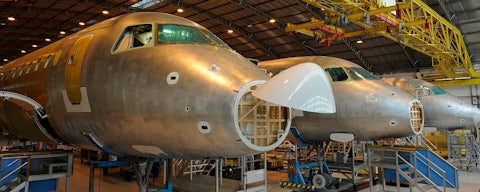- Case study
How procurement fuels growth for an aerostructures manufacturer
And makes its biggest customer more competitive

Who we worked with
A global aerostructures manufacturer.
What the company needed
To help its largest client—an aircraft company—become more competitive while reducing its own direct material costs by 20%.
How we helped
- First, we ran a diagnostic assessment of the manufacturer’s direct sourcing and procurement process and identified areas for improvement
- Then, we went to work on the problem areas, fostering crossfunctional collaboration, identifying and developing suppliers in best-cost countries, and creating a robust RFX process
- We also improved supplier negotiation and contract execution
What the company got
Lower direct material costs, a leaner and less risky supply base—and the gratitude of its biggest customer.
This aerostructure manufacturer’s largest customer was struggling to keep supply chain costs low. The customer directed the manufacturer to help make it more competitive—so that it could sell more airplanes—by cutting its direct material costs by 20%. That’s when the manufacturer turned to us for help. Working together, we found ways to rapidly reduce material costs.
Challenge
Simplify and fast-track direct sourcing
The aircraft industry is experiencing growth on the back of strong travel demand. To keep pace, aircraft companies are increasing production — which puts pressure on the industry’s supply chain. To sell more airplanes, aircraft companies depend on suppliers like our client, an aerostructures manufacturer, to help them cope with the stress and reduce costs.
To quickly respond to the customer’s request to reduce direct material costs by 20%, our client needed to renegotiate supplier contracts — a task hampered by its complicated and inefficient procurement processes. Some of the challenges:
- Unwieldy systems made supplier data capture and analysis difficult — and there was no single view of supplier performance
- Sourcing teams, which operated in silos across multiple direct commodities, didn’t communicate well with key stakeholders in procurement and finance
- Long source-to-contract timelines of up to six months, making it difficult to execute contracts rapidly
- A lack of resources and expertise to transform internal procurement
Take a copy for yourself
Solution
A comprehensive six-step approach for streamlining direct sourcing
Here’s how it all played out:
Step one: Diagnostic assessment
We conducted a two-week assessment to measure the maturity and effectiveness of the manufacturer’s existing direct sourcing process. After identifying gaps, we:
- Shared best practices for restructuring and cleaning supplier data
- Used market intelligence to develop a sourcing strategy that involved finding best-cost countries and identifying suppliers by capability
- Formed a project plan to improve sourcing execution, and brought all suppliers to the same payment terms
- Analyzed existing contracts and reported KPIs and out clauses to take corrective action for non-performance
Step two: Procurement transformation
- Formed a joint sourcing team with members from the manufacturer’s finance, procurement, quality assurance, and purchasing departments. We also created a project management organization to facilitate communication across this team
- Helped the manufacturer evolve from sourcing one-off parts to developing a comprehensive category strategy. Plus, we grouped similar parts that fit suppliers’ profiles and put out bids to those suppliers
Step three: Site visits and RFX development
- Provided resources and ran more than 80 site visits within two months to assess and score suppliers against the qualification criteria
- Identified 27 suppliers from best-cost countries to supplement existing supplier capabilities
- Recommended existing suppliers who showed superior financial performance, quality, and timeliness of delivery
- Created a repeatable RFX process by providing bid calculators. We then trained the team to use these calculators to analyze bid responses and arrive at target pricing for hyper-competitive negotiations
Step four: Contract management
- Helped create contracts in line with compliance requirements established by the Federal Aviation Authorities (FAA)
- Standardized terms and conditions of NDAs and MSAs
- Supported FAA reporting requirements, including the completion of part movement and import compliance forms
Step five: Supplier negotiation
- Got the manufacturer’s suppliers to agree to purchasing terms and conditions before negotiating price
- Created a framework to speed up executive approvals during the sourcing process to avoid bottlenecks and reduce negotiation timelines
Step six: Supplier development
- Onboarded new suppliers, working with them and the manufacturer to ensure that production met design control requirements
- Helped suppliers comply with established ethical standards
- Trained suppliers on the manufacturer’s procurement policies, including payment terms and lead times
Impact
A clean, rationalized supplier base. Speedier contract execution. Massive savings.
The manufacturer achieved much more than what it had initially expected. Here’s how it benefitted after we fundamentally changed its approach to direct sourcing and negotiation:
- Strategic sourcing of direct materials helped it meet its customer’s expectations by creating annual savings in direct material costs of $200-300 million. The manufacturer estimates these savings equate to $1.3 billion over the lifetime of airplane contracts
- Consolidation brought the number of suppliers down by 75%, minimizing supplier management costs and mitigating supplier risks
- Source to contract timelines came down to three months, so the manufacturer could efficiently source nearly 8,000 critical parts and components in just eight months
We not only helped the manufacturer transform direct procurement. We also helped its largest customer reduce production costs and earn more airplane contracts, which strengthened relationships between all parties.